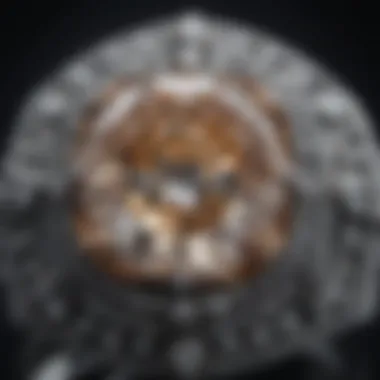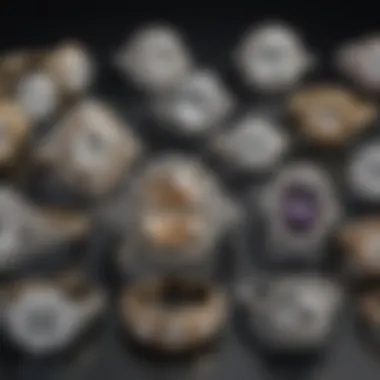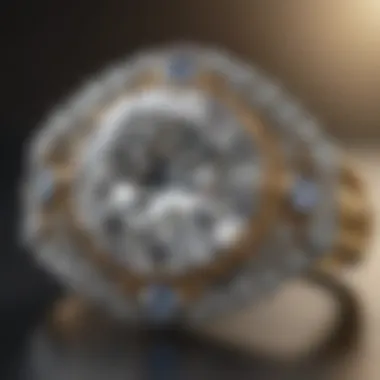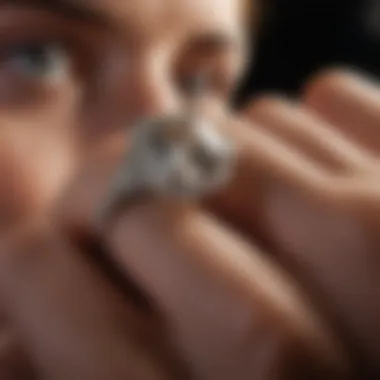Exploring the Allure of Antique Cut Diamond Rings


Intro
Gemstone Overview
Definition and Characteristics
Antique cut diamonds are distinct from modern cuts like the brilliant round. Each antique cut possesses unique traits. The early diamond cutters aimed for maximum sparkle but often prioritized the stone's natural shape and clarity. Common antique cuts include the Old Mine cut, Old European cut, and Rose cut.
- Old Mine Cut: Characterized by a deep cut, larger facets, and a cushion shape.
- Old European Cut: Recognized for its round shape, larger table, and more symmetrical facets compared to the Old Mine cut.
- Rose Cut: Features a flat bottom and a domed top with triangular facets, known for a softer brilliance.
Classification of Gemstones
Gemstones, including diamonds, are categorized based on various factors. The two main classifications include:
- Precious Gemstones: This category includes diamonds, sapphires, rubies, and emeralds. These stones are mined and processed for their rarity and value.
- Semi-Precious Gemstones: These include garnets, amethysts, and tourmalines.
Antique cut diamonds, while precious, carry a unique designation due to their age and cutting technique. This sets them apart from modern gemstones.
Historical Significance
Ancient Uses and Cultural Importance
Historically, diamonds were revered for their brilliance and alleged protective properties. Ancient Indian texts mention their use in adornment and ceremonial contexts. In western cultures, diamonds became symbols of power and love, especially during the Victorian era, when engagement rings gained prominence.
Myths and Legends Surrounding Gemstones
Various myths envelop diamonds. Some cultures believed diamonds could bring prosperity and protection. The ancient Greeks thought diamonds were tears of the gods, exemplifying fearlessness and invincibility.
"Diamonds have been woven into the very fabric of human experience, carrying meanings that manifest in both charm and mystique."
Understanding Antique Cut Diamonds
Understanding antique cut diamonds is crucial for comprehending their unique place in the jewelry market. These diamonds are not merely stones; they are pieces of history intertwined with artisanal craftsmanship. Each antique cut diamond carries stories of bygone eras, reflecting the aesthetic preferences and technological capabilities of the time it was crafted. Knowing the definition, historical significance, and their comparison against modern cuts helps enthusiasts, collectors, and prospective buyers appreciate the depth of these gems.
Definition and Characteristics
Antique cut diamonds possess defining characteristics that set them apart from modern variations. They feature relatively larger facets, which creates a distinct sparkling effect. The symmetry is often less precise than that found in contemporary cuts like the round brilliant. These stones typically have a more subdued brilliance, emphasizing a soft, warm glow. Common antique cuts include the old mine cut and the old European cut, both known for their unique shapes and historical context.
Historical Relevance
The historical relevance of antique cut diamonds adds layers of richness to their appeal. Emerging in various periods, these cuts align with the art movements and societal values of their time. For instance, the old mine cut hails from the 18th century, coinciding with the romanticism of that era. Collectors often seek these gems not just for their beauty but for their connection to specific historical moments. As such, they serve as tangible links to the past, capturing the artistry and techniques from different periods.
Comparison with Modern Cuts
When comparing antique cut diamonds with modern cuts, significant differences emerge. Modern cuts, such as the round brilliant, focus on maximizing light return and brilliance through precise angles. This results in a more vivid sparkle. In contrast, antique cuts prioritize visual warmth and character over sheer brightness. This difference reflects evolving design philosophies in gemology. Enthusiasts may prefer antique cuts for their vintage charm, while others may gravitate to modern cuts for their contemporary aesthetics.
Understanding these distinctions not only enriches one’s appreciation of antique diamonds but also informs better purchasing decisions.
Types of Antique Cuts
Old Mine Cut


The Old Mine Cut, prominent from the 18th century through the early 20th century, is known for its distinctive square shape with rounded corners. This cut features a larger culet, which is the flat facet at the bottom of the diamond, allowing for light to reflect in a unique manner. This creates a warm, romantic glow, making these stones especially desirable for antique jewelry enthusiasts. The cut itself resulted from handcrafting techniques, using less advanced technology than today’s methods.
One key feature of Old Mine Cuts is their depth and table size. The depth tends to exceed that of contemporary cuts, leading to a different play of light. Collectors should consider the overall quality of the diamond, as they can often reveal natural inclusions due to the cutting methods of the time. With growing popularity, Old Mine Cuts offer significant potential for appreciation in value.
Old European Cut
The Old European Cut emerged in the late 19th century as a precursor to the modern round brilliant cut. It is characterized by its round shape and a larger table than the Old Mine Cut, allowing better light reflection. This cut has a smaller culet and more symmetrical facets, enhancing its sparkling appearance.
Moreover, the Old European Cut reflects the technological advances of its time, primarily due to the introduction of the steam-powered cutting wheel. This advancement enabled artisans to create more precise cuts. Collectors appreciate the Old European Cut not just for its beauty but also for the craftsmanship that went into its creation. These diamonds often carry a distinct charm, embodying the elegance of their era.
Rose Cut
The Rose Cut is recognized for its unique, flat back and multiple facets that form a dome shape. These diamonds are typically cut in a range of shapes, including triangle or oval. Their faceting consists of a mix of flat and triangular shapes above the table, which creates a soft reflection of light rather than the intense brilliance seen in modern cuts.
Originally popular during the 16th to 18th centuries, the Rose Cut has regained popularity in contemporary designs, particularly in vintage-inspired jewelry. This cut offers a romantic and understated elegance, appealing to those who seek pieces with historical significance. As a collector, understanding the nuances of the Rose Cut can enhance the appreciation of its role in antique jewelry.
Single Cut
The Single Cut is one of the simplest diamond cuts, composed of fewer facets—typically 18. These diamonds are small and often used as accent stones in more elaborate designs. Though it may appear less brilliant than other cuts, the Single Cut has its charm, offering a vintage look that works well in a variety of settings.
This cut was prevalent from the 19th century onwards, mainly for low-cost jewelry. Collectors might find this cut in cluster rings and art deco pieces. The relatively simple nature of the cut allows it to blend effortlessly with other types of stones, making it a popular choice for intricate designs.
The Craftsmanship Behind Antique Cuts
The craftsmanship of antique cut diamonds is not just an artistic endeavor; it serves as a historical narrative woven into each gem. This section explores the essential role that craftsmanship plays in antique cuts, elucidating the careful techniques and artisanal influences that define these exquisite pieces.
Techniques of the Era
Antique diamond cuts were shaped using hand-powered tools and methods that required immense skill. The absence of modern technology meant that artisans had to rely heavily on their experience and intuition. Some prevalent cutting techniques included the use of the eponymous lapidary wheel, which rotated slowly to achieve precise facets. Each facet was painstakingly polished by hand, giving rise to the irregular, yet unique, shapes that characterize these diamonds.
Moreover, techniques like the blocked cut and table cut, prevalent in the 18th and 19th centuries, exemplified the ingenuity of the time. Artisans understood how light interacted with the diamond's facets and designed the cuts to enhance this effect, creating a balance between brilliance and subtlety. This thoughtful interplay between light and form showcases craftsmanship that transcends mere aesthetics.
Artisan Influence
The influence of individual artisans cannot be overstated in the realm of antique diamonds. Each craftsman possessed distinct styles and approaches, which imparted personal flair to their pieces. Artisans often specialized in particular cuts, learning their trade in family businesses or through apprenticeships that spanned years.
Artisans were also influenced by the cultural and economic context of their time. For instance, the Romantic period led many jewelers to create more intricate designs that emphasized sentimental value. As a result, rings with antique cuts became symbols of love and commitment, often featuring elaborate engravings or designs that echoed the craftsmanship of the era.
In contemporary contexts, the appreciation for these artisans has surged. Modern designers are taking cues from historical techniques, incorporating antique cuts into new designs while maintaining respect for the original craftsmanship. This renaissance in artisanal skill ensures that the legacy of antique diamond cuts continues to inspire both collectors and jewelers alike.
"Every antique diamond ring carries a piece of history and craftsmanship that tells a story. "
Understanding the craftsmanship behind antique cuts is vital for both collectors and enthusiasts. It serves as a reminder that each piece is not just a jewel, but a testament to the skills and stories of those who came before us.
Cultural Significance of Antique Diamonds
The cultural significance of antique diamonds extends beyond mere adornment. These stones reflect historical narratives and societal values prevalent at the time of their creation. Each antique diamond cut embodies a story, a moment, or a sentiment that resonates with various cultures. Understanding this significance enriches one's appreciation for not only the craftsmanship but also the emotional connections these pieces represent.
Historically, diamonds have been associated with wealth and power. However, antique cuts often carry a deeper meaning. They symbolize craftsmanship and artistry, as each facet was carefully shaped by skilled artisans who dedicated themselves to their trade. These cuts were often made during periods of significant societal change, such as the Victorian era, where jewelry became a means to express personal and familial identities.
Influence in Historical Contexts


The historical contexts surrounding antique diamonds reveal much about the eras they come from. During the 17th and 18th centuries, diamonds were not just gemstones; they were status symbols. In a world where social standing was paramount, owning an antique cut diamond meant being part of the upper echelons of society. Through their unique shapes and designs, these diamonds often denoted the capabilities and preferences of the time.
For example, the Old Mine Cut became popular in the late 18th and early 19th centuries, largely as a result of diamond discoveries in Brazil. This cut reflected the romanticism of the era, with its deep, rich facets capturing the light beautifully. It was a period marked by lavish ballrooms and courtships, where diamonds played a crucial role in expressions of love and commitment. Women would often receive these pieces as tokens of affection, deepening their sentimental value.
Symbolism Across Eras
Antique diamonds also carry various forms of symbolism that differ across cultures and time periods. The rose cut, for instance, emerged in the 16th century, symbolizing the connection between beauty and fragility. It is said that its shape mimics the petals of a rose, embodying love and devotion. Thus, these diamonds were ideal for engagements and weddings, cementing their place in romantic traditions.
In contrast, the Old European Cut, seen in the late Victorian period, embodies a shift towards modernity. Its round shape and larger facets represented a colorful brilliance that mirrored the Victorian idealism of progress and innovation. This cut became increasingly popular for engagement rings, highlighting the changing societal norms regarding love and marriage.
"Antique diamonds tell stories that shape cultural identities, allowing us to glimpse into the past while reflecting our own values and sentiments today."
In summary, the cultural significance of antique diamonds is multi-faceted, highlighting connections to history, status, and personal meaning. They are not merely objects of beauty but are vessels of heritage, stories, and emotion that continue to resonate in contemporary society.
Market Trends and Valuation
In recent years, there has been increased appreciation for vintage aesthetics in jewelry, leading to a resurgence in the popularity of antique cut rings. As consumers look for pieces with historical significance and craftsmanship, the value of these rings typically appreciates. With a growing interest in sustainable and ethically sourced jewelry, antique cut diamonds fit this narrative well, as they represent a form of recycling luxury.
Current Market Analysis
- Rising Demand: The demand for antique cut diamonds has been steadily increasing, leading to price stabilization or growth in many markets.
- Online Marketplaces: Platforms such as Etsy and specialized antique jewelry websites are facilitating easier access to these unique items.
- Auction Houses: Renowned auction houses have also seen successes in selling antique cut diamonds, drawing attention to the market.
Factors Affecting Value
- Quality of the Stone: The inherent qualities of the diamond, including clarity, color, and carat weight, remain pivotal in determining value.
- Craftsmanship: The skill with which the ring was crafted influences its desirability. Rings from renowned artisans often command higher prices.
- Historical Significance: Pieces with well-documented provenance or those linked to notable historical figures can fetch significantly higher valuations.
- Market Conditions: Economic factors, including market demand and rarity of specific styles, can dictate price fluctuations.
What to Look For
You should also assess the overall condition of the ring. Look for signs of damage or repair. A well-maintained ring holds more value. Another essential element is the setting. Antique rings may come in a variety of settings that compliment the diamond itself.
Some key points to consider include:
- Provenance: Understand the history behind the piece.
- Artisan Marks: Look for hallmarks or other indicators of the maker's identity.
- Accompanying Documentation: If available, any papers can enhance the ring's value.
Finding Reputable Sources
Finding trusted sources for purchasing antique rings is imperative. Look for established jewelry dealers who specialize in antique and vintage items. Galleries dedicated to antique jewelry often provide a depth of knowledge about their pieces. It is beneficial to seek the opinion of a gemologist or appraiser during your search.
Online marketplaces, while convenient, require caution. Favor reputable websites that offer return policies and transparent information about their items. Reviews and ratings can guide your choices as well.
Wherever you choose to shop, ensure that the seller provides sufficient information about the ring's origin and characteristics. This practice not only protects your investment but also enhances your understanding of the piece's value.
Understanding Certification
It is essential to note that antique diamonds may not always possess modern certificates. In such cases, a graded report from a respected appraiser can serve as an alternative. Ensure that this assessment covers clarity, color, cut, and carat weight.
In summary, understanding the significance of certification will enhance your purchasing knowledge and ensure the ring's authenticity. Knowing if a ring is certified can influence its valuation and your overall purchasing experience.
Caring for Antique Cut Diamonds
Caring for antique cut diamonds is essential for preserving their beauty and historical significance. These diamonds are not just gemstones; they represent a craft that has evolved over centuries. With delicate cutting techniques and unique styles, antique cut diamonds require thoughtful maintenance. Proper care adds longevity to these pieces, ensuring they remain vibrant for future generations.


Cleaning Techniques
Cleaning antique cut diamonds requires a gentle approach to avoid any potential damage. Abrasive cleaners or harsh chemicals can tarnish the surface or dull the shine of the diamond. Instead, consider the following effective methods:
- Mild Soap Solution: Use lukewarm water mixed with a small amount of mild dish soap. This mix can clean the diamond without harming it.
- Soft Brush: Employ a soft-bristled toothbrush to reach crevices. This helps remove dirt and grime without scratching the surface.
- Lint-Free Cloth: After cleaning, use a lint-free cloth to dry and buff the diamond, enhancing its brilliance.
Always ensure that the cleaning process is done carefully. The vintage nature of these diamonds warrants special attention.
Storage Considerations
Proper storage of antique cut diamonds is crucial for their preservation. The conditions in which they are kept play a significant role in maintaining their quality. Here are important aspects to consider:
- Individual Soft Pouches: Store each piece in a soft pouch to prevent scratching or tangling with other jewelry.
- Temperature and Humidity Control: Avoid extremes in temperature and humidity. This can cause damage to both the diamond and its setting.
- Avoid Direct Sunlight: Prolonged exposure to direct sunlight can fade the colors or create unwanted discoloration in some older settings.
"Antique cut diamonds thrive on careful handling and appropriate storage conditions to retain their timeless charm."
By following the above cleaning techniques and storage tips, gem enthusiasts can maintain the luster and historical value of their antique cut diamonds.
Antique Cut Diamonds in Contemporary Design
Antique cut diamonds have seen a resurgence in modern jewelry design, appealing to those who value individuality and historical significance. These diamonds are uniquely crafted to reflect a particular era's artistry and skill, making them appealing not just as gemstones but as pieces of history. The relevance of antique cut diamonds in contemporary design lies in their ability to bridge the past and the present, offering a timeless allure that speaks to both tradition and modernity.
In today’s jewelry industry, integrating antique cuts into contemporary styles offers several benefits, allowing designers to tap into rich heritage while creating pieces that resonate with today’s aesthetics. They provide an organic feel, distinct from the meticulously faceted stones of contemporary cuts. Antique cuts often have a soft glow, stemming from their unique faceting patterns, which catch light in various ways, creating a charm that modern diamonds can lack.
Integration with Modern Styles
The integration of antique cut diamonds into modern jewelry focuses on how these vintage cuts complement current design trends. Jewelers frequently incorporate antique cuts into various settings, blending their historical touch with contemporary elements. For instance, settings that feature minimalistic designs can showcase the intricate beauty of the antique diamond without overwhelming it.
Designers also explore innovative techniques to bring antique cut diamonds into the realm of modern fashion. This includes:
- Mixing Materials: Combining antique diamonds with contemporary metals like rose gold or even mixed metals enhances visual interest.
- Layered Styles: Many modern designs favor stacked rings or layered necklaces, where antique diamonds can serve as signature pieces within a cohesive look.
- Custom Settings: Customization allows for antique cut diamonds to be incorporated in ways that reflect personal styles, making each piece unique.
The appeal of antique diamonds in modern settings lies in their contrast to the sharp, precise lines of modern cuts. The softer edges and intricate facets of antique stones allow them to harmonize beautifully with current trends while standing out as unique pieces.
Popularity Among Designers
The growing popularity of antique cut diamonds among designers is noteworthy. Many jewelers, both established and emerging, recognize the demand for unique pieces that tell a story. This shift can be attributed to several factors:
- Sustainable Choice: As consumers become more aware of ethical sourcing, purchasing antique diamonds is seen as a sustainable choice. They are often repurposed from older pieces, reducing the demand for newly mined stones.
- Distinctive Aesthetic: Designers appreciate the distinct character of antique cuts, which can add a unique narrative to their collections. Each diamond carries its history, which resonates with buyers looking for more than just a beautiful stone.
- Client Demand: Many clients are seeking individuality in their jewelry. Antique cut diamonds are often favored by those who want something that stands apart from mainstream designs.
"Antique cut diamonds possess an inherent charm and depth that speaks to the story of the wearer, creating meaningful connections through design."
The Future of Antique Cut Diamonds
Predicted Trends
Antique cut diamonds are expected to gain increased popularity in various markets as consumers lean towards unique and storied pieces. This shift reflects a broader trend valuing individuality over mass production. Key predicted trends include:
- Personalization: Consumers are increasingly seeking pieces that reflect their personal stories. Antique cut diamonds, with their unique imperfections and historical narratives, serve as perfect symbols of individuality.
- Hybrid Designs: Jewelers may incorporate antique cuts into contemporary settings. This merging of old and new appeals to a wide audience, combining the charm of history with modern aesthetics.
- Investment Value: As collectors recognize the inherent value of antique designs, we may see a rise in investment-driven purchases, particularly as younger demographics begin to prioritize investments in unique jewelry.
Sustainability and Ethical Considerations
With a rising consciousness about sustainability, antique cut diamonds are poised to become a favored choice for environmentally-conscious consumers. The sourcing of these diamonds often entails significantly lower environmental impact compared to newly mined stones. Key points to consider include:
- Reused Materials: Antique rings often consist of repurposed metals and stones, reducing the need for new resources.
- Ethical Sourcing: Buying antique diamonds can minimize human and environmental costs associated with new mining operations. This reduced carbon footprint aligns with the growing demand for ethical consumerism.
"The future of antique cut diamonds is not just in their beauty, but in their story and impact on the world."
Trends indicating a rising interest in sustainability and transparency within the supply chain are likely to enhance the antique diamond market further. As a result, antique cut diamonds will not only be a fashionable choice but also a responsible one. This growing preference can drive continued demand for these pieces, ensuring they remain relevant in the contemporary jewelry landscape.







